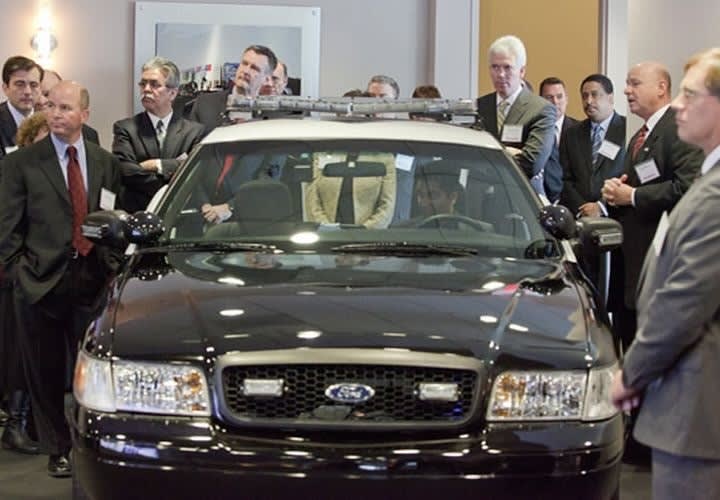Consider what you would do in each of the following scenarios, and ask yourself what technologies you would want on hand to deal with these crises more effectively:
1. An active shooter terrorizes a military facility.
Raytheon's new Public Safety Regional Technology Center in Southern California provides an avenue for developing next-gen law enforcement technologies.

Raytheon executives and guests watch a video feed provided by a cruiser-mounted camera. Photo: Raytheon
Consider what you would do in each of the following scenarios, and ask yourself what technologies you would want on hand to deal with these crises more effectively:
1. An active shooter terrorizes a military facility.
2. A terrorist with a bomb-like device strapped to his body enters Los Angeles International Airport's Terminal 4.
3. A suspect with a deadly gas device is about to walk into a state building.
These questions were posed to public safety leaders during the first counterterrorism workshop at the University of California, Los Angeles' Public Safety Network Systems Laboratory in December. The attendees included representatives from the FBI, LAPD, Los Angeles World Airports and San Bernardino County Sheriff's Department.
They drew up a wish list (see below) of future technologies. Of course, any privacy concerns would need to be addressed while these technologies are being developed or adapted for police work, not after the fact.
Next Generation 9-1-1 that can receive incident-related pictures from mobile phones with geo-location data attached. Also, social media posts and tweets sent from the public that contain longitude and latitude coordinates.
Communications systems that are interoperable, resilient, redundant, and secure. First responders should be able to communicate with each other through an open architecture system that integrates any communications device.
Facial recognition technologies and Future Attribute Screening Technology (FAST) that can help identify people who may be dangerous.
Automated license plate readers at key facilities or city entry and exit points for alerting and investigative purposes.
Blue force tracking that shows where team members are in three dimensions. This could be used within buildings and include building schematics.
Raytheon's new Public Safety Regional Technology Center in Downey, Calif., near Los Angeles provides one avenue for developing these technologies. This 27,000-square-foot facility opened in February and has been built to design, test, and certify public safety technologies. The center focuses on addressing first responders' needs by working on technologies that can improve public safety communications, reduce a department's costs, and save lives.
Several battlefield-tested devices that Raytheon has adapted for public safety use are also on display and can be tried out in hands-on demonstrations. There's the Boomerang shooter detection system that helps immediately locate the source of firearms being discharged; the Controlled Impact Rescue Tool that's capable of cutting through a reinforced concrete wall up to four times faster than traditional methods of drilling or sawing; and TransTalk, a mobile phone app that directly translates languages, including a soon-to-be-released English-to-Spanish version.
Any police department is welcome to use the facility for testing purposes, as well as to propose an idea or issue that researchers, industry and the public safety community can solve on a collaborative basis. I wish we had a place like this when I was with the LAPD.
Learn more about the Public Safety Regional Technology Center, by clicking here.
Related:
In the relentless heat of summer and even early fall in some parts of the country, officers face the important task of protecting their K-9 partners while working in sweltering temperatures. Recognizing changes in a dog’s behavior is the key.
Read More →ILEETA is a complete resource for trainers to address trainers' needs. Its mission is to enhance the skills and safety of criminal justice practitioners while fostering stronger and safer communities.
Read More →Technologies for improving law enforcement training and training management were some of the highlights at this year's show.
Read More →The 2024 pursuit-rated vehicles--all pickup trucks or SUVs, including two battery electric models the Chevrolet Blazer EV AWD and Ford Mustang Mach-E--were put through their paces.
Read More →As more alternative-fuel and hybrid vehicles hit the road, police and other first responders need to understand that they are no more dangerous than conventional vehicles. However, there are certain safety considerations every cop should know.
Read More →Garmont Tactical has found wide acceptance by military boot buyers, but now the company is trying to better respond to the needs of police officers. Many cops now are not fans of 8-inch boots, so Garmont is adapting.
Read More →Through our magazine and website and our Police Technology eXchange event, we promise to provide you with information and access to resources to help you do your job safer and better.
Read More →The Harris County Sheriff's Office is a model for other agencies that want to learn about crisis intervention and mental health crisis response. Sgt. Jose Gomez shares the story of their programs and provides 10 tips for mental health crisis call response
Read More →Mike Barham, of Galco Holsters, shares five important considerations to keep in mind when you buy off-duty concealed or plain-clothes carry holsters.
Read More →While the burden of accurately reporting use-of-force situations is on an individual deputy or officer, the person reviewing those reports shares in the responsibility of making sure the reporting is done properly, with clear details included.
Read More →